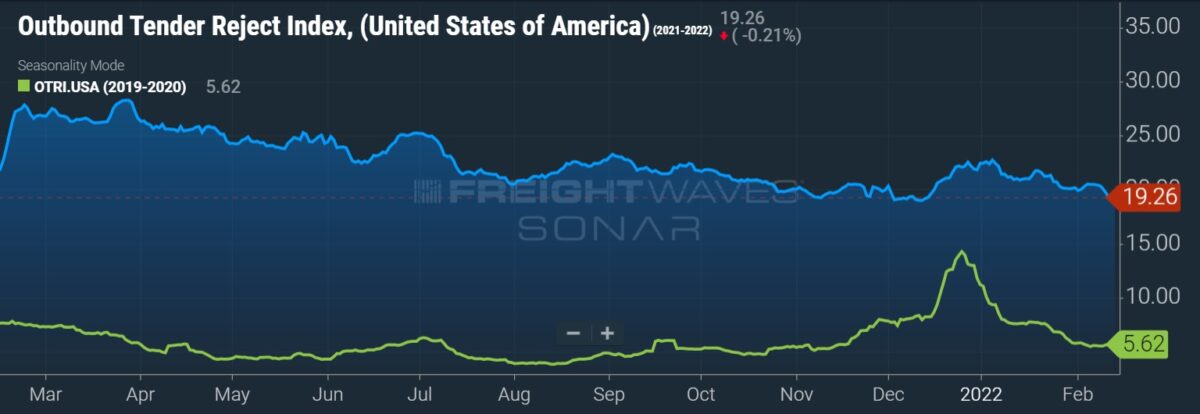Freight shipments fell 7.4% seasonally adjusted from December to January, according to a Monday report from Cass Information Systems. The volumes component of the Cass Freight Index was also 2.9% lower year-over-year. The report called out a rise in omicron cases as the reason.
The drop in volumes “is about as good an answer as we have to the question of how big an impact Omicron-related absenteeism and quarantines had on the freight economy,” ACT Research’s Tim Denoyer commented in the report.
He doesn’t believe consumer demand is receding even though ships awaiting berths at Southern California ports have declined nearly 30% in recent weeks.
“While these effects are lingering in February, they are beginning to fade and we expect a rebound in the coming months as case counts fall sharply,” Denoyer continued. “This was not a demand-driven decline, as inventories are still lean and consumer balance sheets strong.”
He pointed to growing cues at East Coast ports as supportive of demand.
Shipments in the month were still 5.5% higher compared to January 2020.
Expenditures were down 6.1% seasonally adjusted from December, but the move was directly tied to the decline in shipments. The month was also up against a tough comparison from the record set in December.
Freight costs were 31.2% higher year-over-year and 56.8% higher than in January of 2020.
The comps get tougher moving forward but Denoyer forecasts a 20% increase in 2022 if typical seasonal patterns hold. The guidance is down from the 25% forecast provided last month and back to the level projected in the November report (published mid-December). The jump in omicron cases prompted the change.
| January 2022 | y/y | 2-year | m/m | m/m (SA) |
| Shipments | -2.9% | 5.5% | -10.8% | -7.4% |
| Expenditures | 31.2% | 56.8% | -8.9% | -6.1% |
| TL Linehaul Index | 7.2% | 15.0% | 1.5% | 1.5% |
Inferred rates (expenditures divided by shipments) were up 3% seasonally adjusted in the month, a record, and 35.1% year-over-year. Inflationary pressure on transportation capacity, tied to absenteeism, was cited as a driver of higher costs. Also, excess freight miles, attributable to slower rail service, is pushing the metric higher. Transloading and rerouting to navigate delivery delays are adding miles and costs.
The report said intermodal’s share loss to truckload increased truck lengths of haul by 20% year-over-year in the month. No material improvement is expected in the near term.
“Chassis production has improved considerably for the past six months, but only enough to turn the direction of the chassis fleet from contraction to slight growth, and the chassis fleet remains far from what is needed to address rail network congestion,” Denoyer added.
The inferred rate index is expected to climb 20% this year, following a 23% increase in 2021.
The Cass Truckload Linehaul Index, a per-mile calculation excluding fuel and accessorials, increased 1.5% from December and 7.2% year-over-year.
The report estimates that the increase in length of haul, mostly for shipments tied to lower linehaul rates, took 280 basis points of growth out of the index during the month. The math assumes a 2.1% decline in rate per mile for each 100-mile increase in length of haul. Denoyer estimates that TL rates tied to freight without notable changes in mileage were 10% higher year-over-year in the month.
“As intermodal network congestion gradually eases over the course of 2022, a reversal to shorter length of haul will likely add upward pressure to this index above and beyond market rate increases,” Denoyer said.
The linehaul index was up 15% on a two-year-stacked comparison and sits just 0.5% off the all-time high set in October.

“In addition to freight carriers, the manufacturing sector, which had recently started to show signs of easing in the everything shortage, is grappling with significant absenteeism. While expected, automotive downtime announcements have increased in February. But Omicron’s needle shape suggests the effects will be brief and set up a springtime rebound,” Denoyer concluded.
Data used in the Cass indexes is derived from freight bills paid by Cass (NASDAQ: CASS), a provider of payment management solutions. Cass processes more than $26 billion in freight payables annually on behalf of customers.
Click for more FreightWaves articles by Todd Maiden.
- Universal Logistics sees bridge blockade as ‘blip’ to strong 2022
- Forward Air on pace to hit 2023 targets early
- Maersk adds US final-mile network in $1.8B deal







